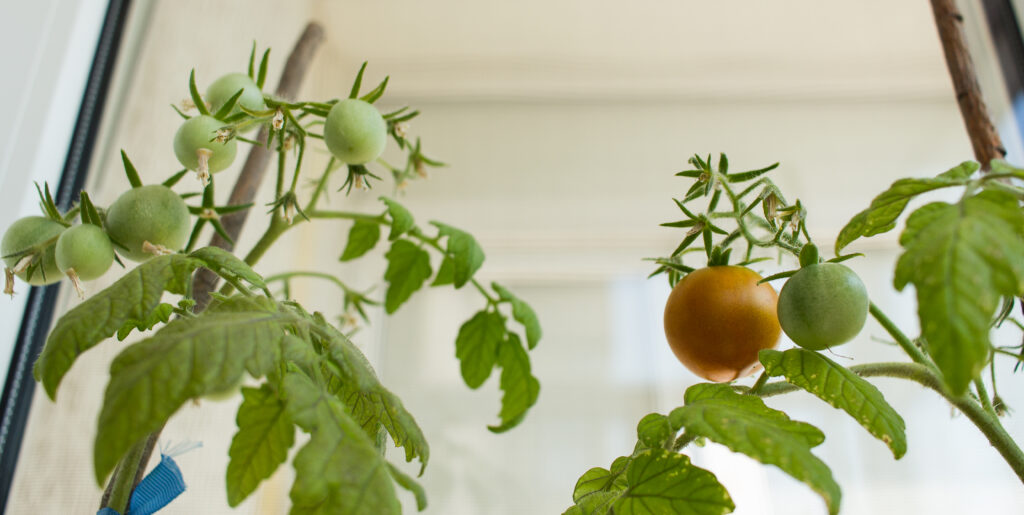Growing tomatoes indoors opens up possibilities for enjoying fresh, homegrown fruit year-round. Whether you’re dealing with limited outdoor space or want to extend your growing season, indoor tomato gardening provides a rewarding way to produce your own food. This comprehensive guide walks you through everything you need to know about growing tomatoes indoors successfully.
Choosing the Right Varieties
Selecting appropriate tomato varieties makes a significant difference in indoor growing success. Determinate varieties, which grow to a predetermined size, often work better in space-constrained indoor environments. Cherry tomatoes like Tiny Tim, Red Robin, and Florida Basket excel indoors due to their compact growth habits and reliable production. These smaller varieties typically produce fruit more quickly and continuously than larger types.
Creating the Perfect Growing Space
Indoor tomatoes need a dedicated growing area with adequate light and good air circulation. Southeast or southwest-facing windows provide optimal natural light, though most indoor tomatoes require supplemental lighting for best results. Create growing zones away from heating vents and cold drafts, as tomatoes prefer stable temperatures between 65-75°F during the day and no lower than 55°F at night.
Essential Growing Equipment
Successful indoor tomato growing requires proper equipment and supplies. Select containers at least 12 inches deep with adequate drainage holes. Use a high-quality potting mix specifically formulated for vegetables, ensuring good drainage and nutrient retention. Install grow lights that provide full-spectrum illumination, adjusting them to accommodate plant growth. Consider adding oscillating fans to improve air circulation and strengthen stems.

Starting Your Plants
Begin your indoor tomato journey with vigorous, healthy plants. Start seeds in small pots filled with seed-starting mix, planting them about ¼ inch deep. Maintain consistent soil moisture and temperatures around 70-75°F for optimal germination. Once seedlings develop their first true leaves, provide 14-16 hours of light daily. Transplant seedlings to larger containers when they reach 6-8 inches tall.
Light Requirements
Lighting plays a crucial role in indoor tomato success. Position grow lights 6-8 inches above young plants, raising them as plants grow. Use timers to maintain consistent day lengths, providing 14-16 hours of light daily. Full-spectrum LED grow lights work excellently for tomatoes, providing the intense light they need while remaining energy efficient. Monitor plant behavior – stretching indicates insufficient light, while leaf curling might signal too much.
Watering and Humidity
Indoor tomatoes require consistent moisture without becoming waterlogged. Water thoroughly when the top inch of soil feels dry, ensuring water flows freely through drainage holes. Use room-temperature water to avoid shocking roots. Maintain moderate humidity levels around your plants through regular misting or humidity trays. Mulching the soil surface helps retain moisture and reduce evaporation.
Nutrient Management
Feed your indoor tomatoes regularly to support healthy growth and fruit production. Begin fertilizing when plants start developing flowers, using a balanced organic fertilizer formulated for vegetables. Apply liquid fertilizer every two weeks during the growing season, or incorporate slow-release granules into your potting mix. Watch for signs of nutrient deficiencies, such as yellowing leaves or poor fruit development.
Training and Support
Provide sturdy support for your growing tomato plants from an early stage. Install stakes, cages, or trellises when transplanting to avoid disturbing roots later. Secure plants to supports using soft plant ties, allowing room for stem growth. Regular pruning helps maintain manageable plant size and improves air circulation. Remove suckers (side shoots) to direct energy toward fruit production rather than excessive foliage.
Pollination Techniques
Indoor tomatoes need help with pollination since they lack natural pollinators. Gently shake flowering stems daily during mid-morning hours when pollen is most viable. Use a small brush to transfer pollen between flowers, or set up a small fan to simulate outdoor breezes. Electronic plant vibrators can also effectively distribute pollen, increasing fruit set rates.
Managing Plant Health
Monitor your plants regularly for signs of problems. Common indoor tomato issues include leaf spot diseases, powdery mildew, and pest infestations. Maintain good air circulation and avoid wetting foliage to prevent fungal problems. Inspect plants weekly for pests like spider mites or whiteflies. Address issues promptly using organic control methods appropriate for indoor environments.
Harvesting and Pruning
Harvest tomatoes when they reach full color but still feel slightly firm. Different varieties show different signs of ripeness, so familiarize yourself with your chosen variety’s characteristics. Regular harvesting encourages continued production. Prune yellowing or damaged leaves promptly to maintain plant health and appearance. Remove any fruit showing signs of blossom end rot or other defects.
Seasonal Adjustments
Adjust care routines seasonally to accommodate changing natural light levels and indoor conditions. Increase artificial lighting during shorter winter days. Monitor humidity more closely when heating systems run frequently. Reduce watering slightly during winter months when growth naturally slows. Consider starting new plants every few months to maintain continuous production.
Maximizing Your Harvest
Optimize fruit production through careful management techniques. Maintain consistent growing conditions to prevent stress-related problems. Remove damaged or diseased fruit promptly to direct energy toward healthy development. Consider succession planting to ensure continuous harvests. Keep detailed records of variety performance to guide future growing decisions.
Your indoor tomato garden provides fresh, flavorful fruit while offering valuable learning experiences. Through careful attention to growing conditions and regular maintenance, you can enjoy homegrown tomatoes regardless of outdoor growing conditions. Remember that each growing space presents unique challenges and opportunities, so stay flexible and adjust your approach based on your plants’ responses.




